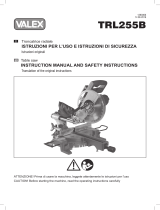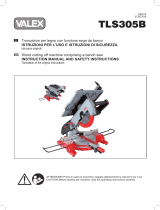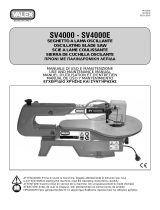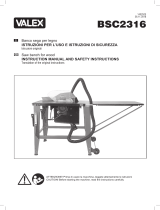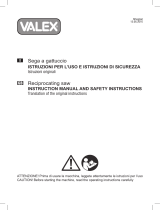Page is loading ...

WTroncL
11.10.2016
Troncatrice per legno con funzione sega da banco
ISTRUZIONI DI SICUREZZA
Istruzioni originali
Wood cutting off machine comprising a bench saw
SAFETY INSTRUCTIONS
Translation of the original instructions
ATTENZIONE! Prima di usare la macchina, leggete attentamente le istruzioni di sicurezza e d’uso
CAUTION! Before starting the machine, carefully read the safety and operating instructions
Final dimension: A4

- 2 -
- Lancio di materiale e polvere verso gli occhi ed il corpo dell’operatore.
Indossate occhiali di protezione e maschera antipolvere.
- Material and dust flying towards the operator’s eyes and body. Use
eye protection and an anti-dust mask.
- Rumore elevato generato dalla macchina. Indossate cuffie a prote-
zione dell’udito.
- Loud noise generated by the machine. Use ear protection.
- Rischio di scossa elettrica con pericolo di morte. Non toccate le parti in tensione
elettrica e mantenete una distanza di sicurezza. Prima di ogni manutenzione
scollegate la spina dalla presa di alimentazione.
- Risk of electric shock and danger of death. Do not touch the electrically
live parts and keep a safe distance. Before any maintenance operations,
unplug the machine from the power supply.
RISCHI RESIDUI
RESIDUAL RISKS
Queste illustrazioni mostrano i rischi residui nell’uso della macchina. Leggete attentamente il libretto istruzioni della macchina.
These illustrations show the main risks involved with using the machine. Read the machine instruction manual carefully.
- Lama e schegge di legno che provocano ferite alle mani. Indossate
guanti protettivi e mantenete una distanza di sicurezza dalla zona di
taglio.
- Blade and sharp burrs which could cut hands. Wear protective gloves
and keep a safe distance from the cutting area.

- 3 -

- 4 -
i
AVVERTENZE DI SICUREZZA GENERALI
1) I SACCHI DI NYLON NON SONO DEI GIOCATTOLI
ATTENZIONE! Pericolo di soffocamento. I sacchi di nylon presenti
nell’imballaggio possono provocare soffocamento se infilati sul
capo e devono essere tenuti lontani dai bambini; se non più riuti-
lizzabili devono essere tagliati e smaltiti nei rifiuti.
2) PERSONE ABILITATE ALL’USO DELLA MACCHINA
L’uso della macchina è vietato ai bambini, alle persone inesperte
non perfettamente a conoscenza delle istruzioni d’uso contenute
nel presente manuale ed agli estranei. Leggi e regolamenti locali
possono prevedere una età minima per l’uso della macchina.
L’operatore deve essere adeguatamente addestrato all’utilizzo, alla
regolazione e al funzionamento in sicurezza della macchina.
3) RESPONSABILITA’ DELL’OPERATORE
L’operatore è responsabile verso terzi di eventuali incidenti o danni
a persone e cose causati dall’uso della macchina.
4) ANTENETE UNA POSIZIONE DI LAVORO STABILE E SICURA
Quando lavorate mantenete una posizione di lavoro stabile e sicura,
non sbilanciatevi.
5) FATE ATTENZIONE ALLA ZONA DI LAVORO
Fate attenzione alle mani, al pezzo in lavorazione, all’utensile di
taglio, ai trucioli prodotti dalla lavorazione e in generale a tutte le
parti in movimento.
6) OPERATE CON ATTENZIONE
Non distraetevi e controllate sempre quello che state facendo:
usate il buon senso. Non usate mai la macchina in condizioni di
stanchezza, malessere, sotto l’effetto di alcool, droghe o farmaci
che riducono la vigilanza.
7) MANTENETE UNA DISTANZA DI SICUREZZA
Mantenete le persone e gli animali lontano dalla vostra zona di
lavoro e dalla macchina. Non toccate le parti che sono in tensione
elettrica.
8) PROTEGGETE IL VOSTRO CORPO
L’uso della macchina genera rumore, calore, polveri, fumi, vi-
brazioni, il lancio di trucioli e schegge. Operate sempre con dei
dispositivi di protezione individuale a norma per evitare lesioni al
corpo, alle mani, agli occhi, all’udito, alle vie respiratorie. Indossate
abbigliamento robusto con maniche e polsini stretti, occhiali di pro-
tezione, guanti da lavoro, cuffie antirumore, maschera antipolvere
e calzature antinfortunistiche. Non indossate abbigliamento largo,
sciarpe, nastri di tessuto e gioielli perché potrebbero impigliarsi
nelle parti in movimento della macchina. Indossare copricapi di
protezione per raccogliere i capelli lunghi. Gli occhiali da vista non
sono adatti a proteggere gli occhi.
9) EFFICIENZA DELLA MACCHINA
Controllate sempre l’efficienza e l’integrità della macchina; se in
cattivo stato può provocare gravi incidenti. Non utilizzate la mac-
china se l’interruttore non consente di accendere o spegnere la
macchina. Se necessario sostituite l’inserto del piano di lavoro.
10) INTEGRITA’ DELLA MACCHINA
Non togliete alcun componente dalla macchina se non espressa-
mente indicato nelle presenti istruzioni e non modificate in alcun
modo la configurazione originale.
11) NON SMONTATE LA MACCHINA
Non smontate per alcun motivo la macchina. Non utilizzate la mac-
china senza le protezioni in posizione in posizione, specialmente
dopo un cambio di modalità.
12) NON MANOMETTETE ALCUN COMPONENTE DELLA MACCHINA
Non manomettete, non modificate, non togliete alcun componente
della macchina.
13) VERIFICATE LA SOLIDITA’ DELLA MACCHINA
Verificate periodicamente il serraggio della viteria della macchina
e il fissaggio della lama.
14)
UTILIZZATE LA MACCHINA IN UN LUOGO BEN AERATO E VENTILATO
La macchina deve essere utilizzata in un luogo ben aerato e
ventilato in modo assicurare un sufficiente raffreddamento e un
ricambio d’aria del locale.
15) NON UTILIZZATE LA MACCHINA IN AMBIENTI PERICOLOSI
Non utilizzate la macchina in un ambiente con pericolo di esplo-
sione e/o incendio, in locali poco ventilati, in presenza di liquidi,
umidità, gas, vapori, acidi ed elementi infiammabili e/o esplosivi.
16) TRASPORTO DELLA MACCHINA
Le operazioni di trasporto della macchina devono essere eseguite
con attenzione. Trasportatela solo in posizione banco sega affer-
randola con due mani sul basamento. Non trasportate la macchina
tirandola per il cavo di alimentazione o altre sue parti.
17)POSIZIONAMENTO DELLA MACCHINA
Posizionate e fissate la macchina mediante bulloneria sopra un
banco da lavoro o piedistallo con superficie piana, solida e inin-
fiammabile che dovrà supportare il peso totale e le sollecitazioni
derivate dall’uso. E’ vietato usare la macchina senza fissarla so-
lidamente e su superfici infiammabili come legno, plastica ecc.
Periodicamente verificate il fissaggio.
18) LAVORATE CON LUMINOSITA’ ADEGUATA
Lavorate solo durante le ore di buona luminosità o con una illumi-
nazione artificiale corrispondente.
19) NON ESPONETE LA MACCHINA AGLI AGENTI ATMOSFERICI
Non lasciate la macchina esposta agli agenti atmosferici quali
pioggia, nebbia, sole, alte o basse temperature.
20) NON TOCCATE LA MACCHINA SE SIETE BAGNATI
Non usare la macchina a piedi nudi o bagnati. Non toccare la
macchina con le mani bagnate.
21) CONTROLLO PRIMA DI AVVIARE LA MACCHINA
Prima di inserire la spina alla rete elettrica verificare che l’interrut-
tore sia su OFF “O” (spento), che il pezzo in lavorazione sia ben
posizionato e supportato, che la testa di taglio sia regolata e che
le chiavi di servizio siano state tolte. Non utilizzate la macchina
se gli inserti sono usurati e le protezioni lama sono rotte o non
funzionano.
22) VERIFICHE CORRETTO MONTAGGIO
Non utilizzate la macchina se il tubo dell’aspiratrucioli/polvere
(non in dotazione) è scollegato e l’aspiratore (non in dotazione) è
spento.
23) VERIFICHE DELLE PROTEZIONI
Controllate che le protezioni della lama non siano danneggiate.
La protezione inferiore lama deve seguire il movimento di salita/
discesa della testa di taglio; non utilizzate la macchina se la pro-
tezione non copre la lama nella posizione di riposo.
24) POSIZIONATE BENE IL PEZZO IN LAVORAZIONE
E’ molto importante per la vostra sicurezza che il pezzo in la-
vorazione sia ben posizionato contro la guida poggiapezzo, che
sia serrato dalla morsa, e che sia supportato alle due estremità
mediante piedistalli (non in dotazione). Il pezzo deve avere lati piani
e perpendicolari come tavole, listelli ecc.; non tagliate rami, tronchi
d’albero o a sezione circolare. Non tagliate pezzi che contengono
chiodi o viti, oppure avvolti da nastro, corde o altro. Non tagliate
pezzi in costa ma appoggiate il lato lungo sulla base della macchi-
na. Non tagliate pezzi a sezione piccola che non possono essere
serrati dalla morsa e/o che si spezzerebbero durante il taglio.
25) MATERIALI NON CONSENTITI
Non è consentita la lavorazione di metalli, materiali plastici, ma-
teriali infiammabili ed esplodenti, materiali che generano polveri e
nebbie pericolose o nocive alla salute.
26) PREVENITE POSSIBILI INCIDENTI
Effettuate sempre una prova di funzionamento a vuoto prima di
iniziare il lavoro; durante questo periodo fate in modo che nessuno
si avvicini alla macchina e mantenete una distanza di sicurezza.
Utilizzate sempre dei dispositivi di protezione individuale. A mac-
china in funzione non toccate la lama, pericolo di lesioni gravi!
Dopo aver sostituito dei componenti effettuate sempre un controllo
generale prima di accingervi alla lavorazione.
27) UTILIZZATE SOLO LAME SPECIFICATE DAL FABBRICANTE
Questa macchina è stata progettata per utilizzare lame specifiche
per il taglio del legno; è vietato utilizzare lame adatte ad altri materiali
e dischi abrasivi. Non utilizzate lame realizzate in acciaio super
rapido HSS. La velocità max stampigliata sulla lama deve essere
sempre maggiore a quella indicata nei dati tecnici della macchina.
Utilizzate lame conformi alle normative in vigore nel paese in cui
vi trovate.
28) MANEGGIATE LA LAMA CON ATTENZIONE
La lama ha parti molto taglienti: maneggiatela con attenzione e
indossate sempre guanti protettivi, pericolo di lesioni gravi!
29) UTILIZZATE SOLO LAME IN PERFETTE CONDIZIONI
Non utilizzate lame danneggiate o deformate; se usurata sostituitela
con una nuova.
30) NON SOLLECITATE LA LAMA

- 5 -
Non sottoponete la lama a sollecitazioni quali: urti, flessioni, pres-
sioni eccessive, tensioni termiche, variazioni irregolari di velocità,
vibrazioni. In queste condizioni l’utensile ha una durata limitata e
può rompersi senza preavviso con pericoloso lancio di frammenti.
31) A MACCHINA IN FUNZIONE NON TOCCATE LE PARTI IN MOVI-
MENTO
ATTENZIONE! Pericolo di ferite gravi! Durante il funzionamento
non toccate la lama e tutte le parti in movimento. Fate attenzione
a come muovete le braccia e le mani. Togliete il pezzo solo dopo
aver spento la macchina e scollegato il cavo di alimentazione
dalla presa elettrica.
32) MACCHINA NON OPERATIVA
Posizionare l’interruttore su OFF “O” (spento), staccate l’alimenta-
zione elettrica scollegando la spina della macchina quando: non la
usate, la lasciate incustodita, la trasportate, il cavo di alimentazione
è danneggiato, fissate e smontate il pezzo in lavorazione, effettuate
le regolazioni, la manutenzione e la pulizia.
33) ATTENDETE L’ARRESTO COMPLETO DELLA MACCHINA
Il motore, le parti meccaniche rotanti e la lama girano ancora per
diversi secondi dopo aver spento la macchina. Durante la fase di
arresto queste parti non devono essere toccate, pericolo di lesioni
gravi!
34) NON ABBANDONATE LA MACCHINA FINCHE’ E IN FUNZIONE
Non abbandonate la macchina finché è in funzione e nella fermata
rimanete accanto fino al completo arresto delle parti in movimento.
35) MANTENETE PULITO E IN ORDINE IL POSTO DI LAVORO
Il disordine e la mancanza di pulizia sono fonti di pericolo. Fate in
modo che attorno alla macchina non ci siano attrezzi od oggetti
che potrebbero essere danneggiati. Non posizionate attrezzi od
oggetti sulla macchina che potrebbero cadere accidentalmente.
Eliminate frequentemente i residui di taglio dalla macchina e dal
pavimento.
36) POLVERI DANNOSE ALLA SALUTE
ATTENZIONE! Le polveri di alcuni tipi di legno sono molto
dannose alla salute. Indossate le protezioni alle vie respirato-
rie, evacuate i trucioli dalla macchina e dotate il locale di un
estrattore per il ricambio dell’aria.
37) LE RIPARAZIONI DEVONO ESSERE EFFETTUATE DA PERSONALE
AUTORIZZATO
Non tentate di riparare la macchina o di accedere a organi interni,
rivolgetevi sempre presso i centri assistenza autorizzati. Interventi
effettuati da personale non autorizzato fa decadere immediatamente
la garanzia e potrebbe generare pericolo. Conservate la prova
d’acquisto per eventuali interventi in garanzia.
38) RICHIEDETE E FATE INSTALLARE SOLO RICAMBI ORIGINALI
Richiedete e fate installare solo ricambi originali, rivolgetevi al
vostro rivenditore di fiducia. L’utilizzo di ricambi non originali fa
decadere la garanzia e potrebbe generare pericolo.
39) RIPONETE LA MACCHINA IN UN LUOGO SICURO
Quando non la usate, riponete la macchina in un luogo asciutto e
lontano dalla portata dei bambini.
40) RISCHI RESIDUI
ATTENZIONE! La scrupolosa osservanza di queste istruzioni
con l’utilizzo dei mezzi di protezione individuale minimizzano i
rischi di incidente ma non li eliminano completamente.
41) ATTENETEVI SEMPRE A QUESTE ISTRUZIONI
Utilizzate la macchina solo nei modi descritti in queste istruzioni.
Non utilizzatela per scopi a cui non è destinata.
AVVERTENZE DI SICUREZZA ELETTRICHE
1) NON TOCCATE LE PARTI IN TENSIONE ELETTRICA
ATTENZIONE! Pericolo di scossa elettrica. Alcune parti della
macchina sono in tensione elettrica.
2) MANTENETE I BAMBINI E GLI ANIMALI LONTANI DAGLI APPA-
RECCHI ELETTRICI
I bambini e gli animali devono essere tenuti lontani dagli apparecchi
collegati alla rete elettrica.
3) VERIFICATE LA TENSIONE DI ALIMENTAZIONE
La tensione di alimentazione deve corrispondere a quella dichiarata
sulla targhetta dati tecnici. Non utilizzate altro tipo di alimentazione.
4) UTILIZZATE UN APPARECCHIO SALVAVITA
È consigliato l’uso di un apparecchio salvavita sulla linea di alimen-
tazione elettrica per un campo di intervento secondo le normative
vigenti nel Paese di utilizzo; consultate il vostro elettricista di fiducia.
5) COLLEGAMENTO ALLA RETE ELETTRICA
Prima di collegare o scollegare la macchina dalla rete di alimen-
tazione, assicuratevi che l’interruttore si trovi nella posizione OFF
“O” (spento).
6) NON MANOMETTETE IL CAVO DI ALIMENTAZIONE
Non manomettete il cavo di alimentazione. Non sostituite la spina
del cavo di alimentazione; utilizzate solo una presa adattata alla
spina della macchina. Utilizzate il cavo di alimentazione esclusi-
vamente per gli scopi a cui è destinato.
7) CONTROLLATE IL CAVO DI ALIMENTAZIONE
Il cavo di alimentazione e il cavo di prolunga (se presente) devono
essere controllati periodicamente e prima di ogni uso per vedere
se presentano segni di danneggiamento o di invecchiamento. Se
non risultassero in buone condizioni scollegate immediatamente il
cavo e non usate la macchina ma fatela riparare presso un centro
di assistenza autorizzato.
8) MANTENETE IL CAVO DI ALIMENTAZIONE IN POSIZIONE SICU-
RA
Tenete il cavo di alimentazione e il cavo di prolunga (se presente)
lontani dalla zona di lavoro e dall’utensile di taglio, da superfici
umide, bagnate, oliate, da bordi taglienti, da fonti di calore, da
combustibili e da zone di transito veicolare e pedonale.
9) NON CALPESTATE O SCHIACCIATE IL CAVO DI ALIMENTAZIONE
Non passate mai sopra il cavo di alimentazione. Siate coscienti
della sua posizione in ogni momento.
10) NON USATE LA MACCHINA IN PRESENZA DI LIQUIDI
Non bagnate la macchina con liquidi e non esponetela ad ambienti
umidi. Non lasciatela all’aperto.
11) UTILIZZATE UN CAVO DI PROLUNGA IDONEO ALLA MACCHINA
Utilizzate solamente cavo per prolunga omologato idoneo alla
potenza della macchina che utilizzate e dimensionato in base alla
sua lunghezza; consultate il vostro elettricista di fiducia.
12) SCOLLEGATE LA MACCHINA IMPUGNANDO SOLO LA SPINA
Per estrarre la spina dalla presa impugnate solo la spina ; non
tirare il cavo!
13) EVITATE IL CONTATTO DEL CORPO CON SUPERFICI MESSE A
MASSA O A TERRA
Evitate il contatto del corpo con superfici messe a massa o a terra,
come frigoriferi, termosifoni, tubi e serramenti metallici ecc. E’ con-
sigliato l’utilizzo di una pedana che isoli elettricamente l’utilizzatore
dal pavimento.

- 6 -
g
GENERAL SAFETY REGULATIONS
1) NYLON BAGS ARE NOT TOYS
WARNING! Suffocation hazard. Nylon packaging bags can cause
suffocation if placed on the head and must be kept out of the
reach of children. If they cannot be reused they must be cut up
and thrown in the garbage.
2) PEOPLE AUTHORISED TO USE THE MACHINE
This machine must not be used by children or any persons not
fully aware of the instructions for use contained in this manual.
Local laws and regulations may establish a minimum age for use
of the machine. The operator must be adequately trained to use,
adjust and safely operate the machine.
3) OPERATOR’S RESPONSIBILITY
The operator is responsible for other people as far as accidents or
damage to people or property caused by the use of the machine
is concerned.
4) MAINTAIN A STABLE AND SAFE WORKING POSITION
When working, maintain a stable, safe position and do not lose
balance.
5) PAY ATTENTION IN THE WORK AREA
Be careful of hands, the piece to be processed, the cutting tool,
chips produced during work and, in general, all parts in motion.
6) USE CAUTION WHILE WORKING
Do not allow yourself to be distracted and always pay attention
to what you are doing. Use your common sense. Never use the
machine when tired, ill or under the influence of alcohol, drugs or
medicines that reduce alertness.
7) KEEP A SAFE DISTANCE FROM THE MACHINE
Keep people and animals away from the machine and your work
area. Do not touch electrically-powered parts.
8) PROTECT YOUR BODY
The use of the machine generates noise, heat, dust, smoke, vibra-
tions, flying chips and splinters. Always use personal protective
equipment in accordance with the law to prevent injury to the
body, hands, eyes, hearing and respiratory tracts. Wear strong
clothing, with tight sleeves and cuffs, eye protection, working
gloves, safety earmuffs, dust masks and safety shoes. Do not
wear loose clothing, scarves, ribbons and jewellery that could be
caught in moving parts of the machine. Wear a protective hairnet
to gather long hair. Normal glasses are not suitable for protecting
your eyes.
9) EFFICIENCY OF THE MACHINE
Always make sure the machine is in good working order and
integral; it could cause serious accidents if in poor conditions. Do
not use the machine if the switch does not allow you to switch
the machine on or off. If necessary, replace the insert of the work
plan.
10) INTEGRITY OF THE MACHINE
Do not remove any components from the machine unless expressly
indicated in these instructions and do not modify the original
configuration in any way.
11) DO NOT DISASSEMBLE THE MACHINE
Do not disassemble the machine for any reason. Do not use the
machine without the guards installed in position, especially after
a mode change.
12) DO NOT TAMPER WITH ANY OF THE MACHINE’S COMPONENTS
Do not tamper, modify or remove any component from the ma-
chine.
13) VERIFY THE SOLIDITY OF THE MACHINE
Periodically check screw and blade tightness.
14) USE THE MACHINE IN A WELL-VENTILATED ROOM
The machine must be used in a well-ventilated area in order to
ensure sufficient cooling and air circulation.
15) DO NOT USE THE MACHINE IN DANGEROUS ENVIRONMENTS
Do not use the machine in areas with a risk of explosion and/or
fire, in poorly ventilated spaces or in the presence of inflammable
and/or explosive materials, dampness, gases, vapours, and acids.
16) MOVING OF THE MACHINE
The machine should be moved with caution. Hold it only with two
hands under the base to move it. Do not attempt to move the
machine by pulling on the power cable or other machine parts.
17) POSITIONING OF THE MACHINE
Use the nuts and bolts to position and secure the machine on the
work bench or stand with a flat, solid and non-flammable surface
that must support the total machine weight and vibrations caused
by use. Using the machine without securing it and on flammable
surfaces such as wood, plastic, etc. is prohibited. Periodically
check fastenings.
18) WORK WITH ADEQUATE LIGHTING
Only work when there is sufficient daylight or suitable artificial
lighting.
19) DO NOT EXPOSE THE MACHINE TO ATMOSPHERIC AGENTS
Do not expose the machine to the elements such as rain, fog, sun,
high, and low temperatures.
20) DO NOT TOUCH THE MACHINE IF YOU ARE WET
Never use this machine with bare or wet feet. Do not touch the
machine with wet hands.
21) CHECK BEFORE STARTING UP THE MACHINE
Before plugging the machine in, make sure the switch is OFF “O”,
that the piece in process is well positioned and supported, the
cutting head is adjusted, and the service keys are removed. Do
not use the machine if the surface inserts are worn and the blade
guards are broken or do not function.
22) CHECK CORRECT ASSEMBLY
Do not use the machine if the chip/dust vacuum tube (not supplied)
is disconnected and the vacuum (not supplied) is off.
23) CHECKING THE PROTECTIONS
Make sure the blade guards are not damaged. The lower blade
guard must follow the ascending/descending motion of the cutting
head. Do not use the machine if the guard does not cover the blade
in the resting position.
24) MAKE SURE THAT THE PIECE TO BE PROCESSED IS WELL PO-
SITIONED
It is very important for your safety that the piece in process is
well positioned against the appropriate supporting guide, that it is
locked against the vice and that its two extremities rest on specific
pedestals (not supplied). The piece must have flat and perpendi-
cular sides such as tables, panels, etc.; do not cut branches, tree
trunks or circular sections. Do not cut pieces that contain nails or
screws or wrapped in tape, cord or other. Do not cut pieces on a
slant. Rest them on the base of the machine. Do not cut in pieces
coast but place the long side on the machine base. Uncut section
pieces small that they can not be tightened from the grip and / or
that they would break during the cutting.
25) PROHIBITED MATERIALS
Cutting metal, plastic, flammable materials, and materials that
generate harmful or toxic dust and vapours is prohibited.
26) PREVENT POSSIBLE ACCIDENTS
Always test operations without a work piece before beginning
work; at this stage, make sure no one gets close to the machine
and keep safety distances. Always use personal safety devices.
When the machine is running, do not touch the blade. Serious
injury hazard! After replacing components, always run a general
check before starting work.
27) ONLY USE BLADES SPECIFIED BY MANUFACTURER
This machine was designed to use specific blades to cut wood;
using blades suited for other materials and for abrasive disks is
prohibited. Do not use HSS, high speed steel blades. The maximum
speed stamped on the blade must always be higher than that
indicated on the machine’s technical specifications. Use blades
which conform to the regulations in force in the country of use.
28) HANDLE THE BLADE WITH CAUTION
The blade has very sharp edges: handle it with caution and always
wear protective gloves. Serious injury hazard!
29) ONLY USE BLADES IN PERFECT WORKING CONDITIONS
Do not use damaged or deformed blades; if worn, replace them
with new blades.
30) DO NOT FORCE THE BLADE
Do not subject the blade to: collision, bending, excessive pressure,
heat, irregular speed changes, vibrations. In these conditions, the
tool has a limited working life and may break without warning with
the risk of flying fragments.
31) DO NOT TOUCH MOVING PARTS WHILE THE MACHINE IS RUN-
NING
WARNING! Serious injury hazard! Do not touch the blade or
any part in motion while the machine is running. Be careful as

- 7 -
to how you move your arms and hands. Only remove the work
piece after turning off and unplugging the machine.
32) MACHINE MALFUNCTION
Turn the switch to OFF “O” (switched off), disconnect the power
supply to the machine by removing the plug from the socket when:
Not in use, left unattended, moved, the power cable is damaged,
when fixing or removing the work piece, during adjustments,
maintenance and cleaning.
33) WAIT FOR THE MACHINE TO STOP COMPLETELY
The motor, the moving parts and the blade continue to run for a
short while after the machine is switched off. During this time,
these parts must not be touched. Serious injury hazard!
34) DO NOT LEAVE THE MACHINE UNATTENDED WHILE RUNNING
Do not leave the machine unattended while running and wait until
all moving parts fully stop before leaving the machine after turning
it off.
35) KEEP THE WORKPLACE CLEAN AND TIDY
Mess and dirt are sources of danger. Make sure there are no tools
or objects around the machine that could be damaged. Do not
place tools or objects on the machine that could accidentally fall.
Frequently eliminate cutting residues from the machine and floor.
36) HARMFUL DUST
WARNING! The dust produced by some types of wood is very
harmful to your health. Wear appropriate masks, extract the saw
dust from the machine and equip the room with an extractor for
air exchange.
37) REPAIRS MUST BE CARRIED OUT BY AUTHORISED PERSON-
NEL
Do not attempt to repair this machine or to gain access to its
internal parts. Always contact an authorised assistance centre.
Service by unauthorised personnel will cause the warranty to be
annulled and could create a dangerous situation. Keep proof of
purchase for warranty service.
38) REQUEST AND HAVE ORIGINAL SPARE PARTS ONLY INSTALLED
Request and use only original spare parts. Please contact your
dealer. The use of non-original spare parts will cause the warranty
to be annulled and could create a dangerous situation.
39) STORE THE MACHINE IN A SAFE PLACE
When not in use, keep the machine in a dry place out of reach of
children.
40) RESIDUAL RISKS
WARNING! Strict observance of the instructions with the use of
individual means of protection minimalists risks of accidents but
does not completely rule them out.
41) ALWAYS FOLLOW THESE INSTRUCTIONS
Only use this machine as described in these instructions. Do not
use it for purposes for which it was not intended.
ELECTRICAL SAFETY REGULATIONS
1) DO NOT TOUCH LIVE PARTS
WARNING! Risk of electric shocks. Some parts of the machine
are electrically-powered.
2) KEEP CHILDREN AND ANIMALS AWAY FROM THE ELECTRICAL
DEVICES
Keep children and animals away from the devices connected to
the power supply.
3) CHECK THE POWER SUPPLY VOLTAGE
The power supply voltage must correspond to that indicated on the
technical data plate. Do not use any other type of power supply.
4) USE A TRIP SWITCH
It is advisable to fit a trip switch on the power supply line that trips
at the levels laid down in standards currently in force in the Country
in which the machine is used. Contact your local electrician.
5) CONNECTION TO THE POWER SUPPLY
Before connecting or disconnecting the machine to or from the
power supply, make sure that the switch is in the OFF “O” position.
6) DO NOT TAMPER WITH THE POWER CABLE
Do not tamper with the power cable. Do not replace the power
cable plug; only use a socket suited for the machine plug. Only
use the power cable as intended.
7) CHECK THE POWER CABLE
The power cable and extension cable (where applicable) must be
checked periodically and must be checked for signs of damage
and wear every time they are used. If they are not found to be in
good condition disconnect them immediately and do not use the
machine until an authorised assistance centre has repaired them.
8) KEEP THE POWER CABLE IN A SAFE POSITION
Keep the power cable and extension cable (where applicable) away
from the working area, damp, wet or oily surfaces, or surfaces
with sharp edges, heat sources, fuel and transit areas for vehicles
or pedestrians.
9) DO NOT STEP ON OR FLATTEN THE POWER CABLE
Never step on the power cable. Be aware of its position at all times.
10) DO NOT USE THE MACHINE IN THE PRESENCE OF LIQUIDS
Do not wet it with liquids and do not expose it to damp envi-
ronments. Do not leave it out in the open.
11) USE AN EXTENSION CABLE SUITABLE FOR THE MACHINE
Only use an extension cable that is suitable for the power of the
machine you are using and sised according to its length; consult
your local electrician.
12) DISCONNECT THE MACHINE BY PULLING THE PLUG ONLY
To remove the plug from the socket, pull on the plug only and not
the power cable!
13) AVOID TOUCHING SURFACES THAT ARE EARTHED
Avoid body contact with earthed surfaces such as refrigerators,
radiators, pipes and metallic fixtures, etc. Using a platform to
electrically insulate the user from the floor is recommended.

/

